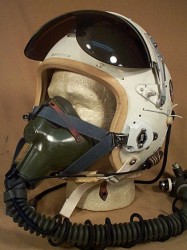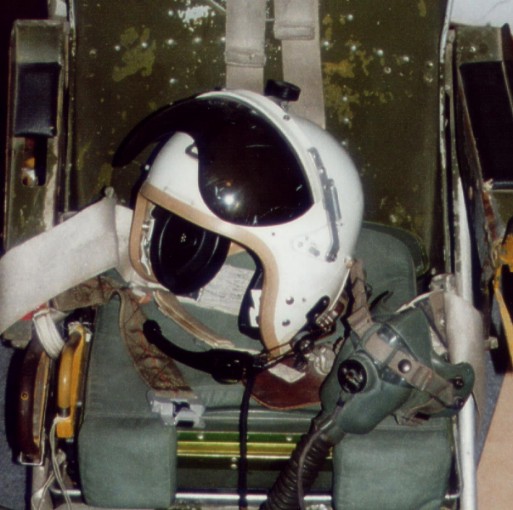
P-series helmet
Message 935:
I checked out the visor additions Ron added to the P-series article and the two images
that formerly were not coming through are now fine (of the first and second versions of
the early visor bar). My observations, mindful of Bluelight14's comments, are as follows:
1) the picture labeled as illustrating a P-4A actually shows a P-4B TO'd helmet. The clues
are the metal mic connector retaining device (right hand lower rear of the helmet shell)
and the nylon earphone upper retaining laces that are visible on a similar plane as the
head sling lace line along the helmet's lower crown circumferential area. (Further,
although the P-4A pigtail com cord may be coiled under the helmet and not visible to view,
it would appear that this helmet does not have one--further evidence that we are looking
at a P-4B, on which both earphones and mic are joined to the AIC/10 aircraft
communications system).
2) The helmet identified as being a P-4B is PROBABLY either a Dutch P-4 work-up or an
incorrect restoration attempt--it does not in any event illustrate a P-4A by USAF specs.
Reasons are that the P-4A never used the side-latch visor (ever), which this helmet has
been fitted with (P-4A TO specifies centerline tracked visor assembly), and the Sierra
Engineering type bayonet receivers are angled down (indicating the helmet was configured
for use with a later model (MBU-5/P or MBU-12/P) 02 mask to which modern "J"
type bayonets were fitted. What is more than likely, is that this is a P-4 helmet (which
did use the 2nd version of the original side-latch visor) that has been updated to P-4B
specs as regards communications components, but which also kept the original side-latch
visor and had newer angled 02 mask receivers added. Although the MBU-5/P mask was commonly
used with the P-4B helmet late in that helmet's service life cycle (and with P-4A helmets
that had been TO'd to P-4B specs), the "correct" bayonet for use with the P-4B
was the straight, single blade (original) Sierra type bayonet. The "T" bayonet
MAY have been used on an MBU-5/P fitted to a P-4B (because a number of pilots kept their
P-4Bs in use, preferring to used them even after the new HGU-2/P was standardized) on a
rare occasion, but this was extraordinarily uncommon and not really "authentic".
The practice of angling the Sierra 02 mask receivers downwards only came into use with the
much more recent "J" type bayonets (early 80s). A number of foreign nations used
the American P-series helmets (just as a few also used the Navy's H-4), as most of you
know, but I have never seen anything resembling the helmet in the image that is
misidentified as a P-4A; the museum that is displaying this helmet should be informed that
their identification is incorrect and that the helmet is probably a much-modified P-4
helmet. Not being able to examine the helmet closely, of course, is a handicap but it is
most reasonable to assume that this is simply a mislabeled and jazzed-up P-4.
This whole matter serves as an excellent illustration of why the P-series helmets can
cause so much confusion today in terms of '"correct" identifications. The
helmets that we see showing up now are very often updated or modified in one manner or
another, creating difficulty in making an absolute identification. Properly termed, a
P-series helmet should be described in the following manner: "P-4 helmet, TO updated
to P-4B specifications". Or, for example, if we are describing an early P-1A that has
been progressively updated to the last P-series TO directive, "P-1A helmet, TO
updated to P-4B specifications". It is inadequate and confusing to label a P-series
helmet only by either its original or final TO update, for our contemporary collector
purposes (although it certainly sufficed for life support people to regard the helmet by
its latest TO update spec when the helmet was in actual service use). OK, this has been a
typically long-winded and ponderous expostulation from that paragon of preternaturally
post-puerile pontifications, (Cheers)..... DocBoink (who is still guzzling high-test
coffee as we "tappity-tap" the keys)
[PS: The attached photo (borrowed from Trey Turner's Check 6 website) shows a P-4A helmet, properly configured with the
rubber mic connector boot (right lower side), pigtail com cord, (most likely) H-75/AIC
spring-loaded earphone headset, and last version center-track visor assembly. It has been
updated by removal of the original leather mask suspension snap-tabs and replacement
thereof with Sierra Engineering type 02 mask receivers, however.]

Message 936:
> As you can see in our other new article it is either a Dutch conversion (see the ox
recievers) or somebody made a mess when rebuilding it. The helmet pictured is part of a
museum collection on an Airforcebase overhere. I have never seen a picture of one looking
like this in use
The shape of the shell strongly suggests that it began life as a P-1 (Lombard design
shape), and has been updated to the point of identity crisis! It might have a tag on the
inside that says "P-4B", but the P-3 visor, current black chinstrap,
screw-attached napestrap, and later type mask recievers are not typical of a factory P-4B.
Rich
Message 937:
That's an astute observation, Rich; actually, I noted the "older" Lombard type
curvilinear shape of the shell, but didn't comment on it. The fact that the helmet has had
many much-newer components added to it does indeed constitute an 'identity crisis' [;-).
It probably is not a conventional American issue P-4...that much seems apparent...and I
doubt if it has any sort of 'standard issue' shell identifier label on the inside anymore,
after undergoing that many mods! Still, it is an interesting helmet and would be even more
so if the exact history behind it were known (or retrievable); any chance of visiting the
Air Force museum it resides at and asking a few questions (Ron)? Cheers, DocBoink
Message 944:
Hi Doc, Sven and I visited the museum and I did this on some more occasions, but it seems
that my small knowledge is even bigger then theirs. At one point I met a former
lifesupport guy there who worked on the P-4 types. Lost track of him but will try again.
He told me also that the Dutch restored the suspensions (leather) with local bought
leather... Bye Ron
I will add a picture of my P- helmet (do not even dare to name it) as used with the Dutch
Airforce on their helicopters. It is lacking the leather tabs but these are in place by
now.

Message 946:
Good morning Ron, Your discovery appears to be congruent with all the many reports from
others who have had similar experiences interacting with museum officials on display
items. That photo of your P-helmet seems to show it is a P-4A with conventional
center-track visor, rubber mic-connector boot, and headphone system. The mask next to it
appears to be a British-type A-13A mask, fitted with the typical manually switched RAF mic
assembly that they used on their A-13A masks. Nice items. Cheers, DocBoink